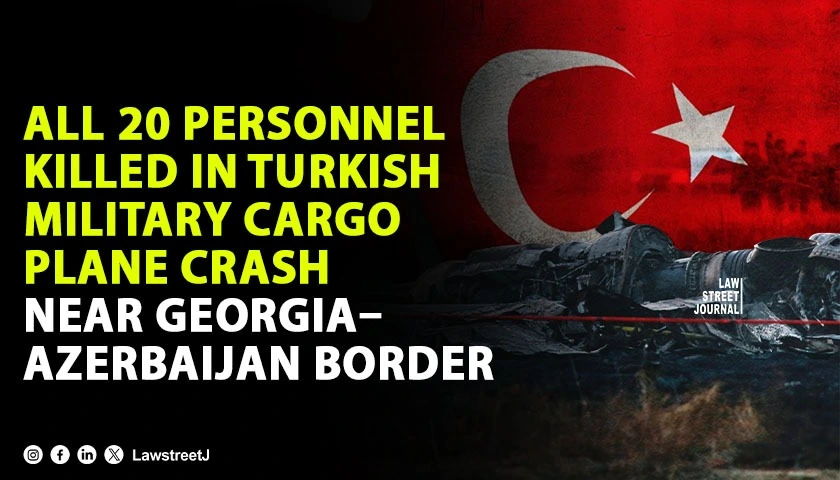New Delhi: All 20 personnel aboard a Turkish Air Force C-130EM Hercules military transport aircraft were confirmed dead after the plane crashed in Georgia’s Sighnaghi municipality on November 11. The aircraft went down near the Georgia–Azerbaijan border, prompting an immediate multinational investigation involving Georgian, Turkish, and Azerbaijani authorities. Officials from Turkey’s Ministry of National Defense stated that the aircraft had departed from Ganja, Azerbaijan, and was heading toward Turkey when it disappeared from radar. The plane crashed in a remote area of eastern Georgia, approximately 80 kilometers from Tbilisi.
Aircraft Details and Crash Site
The crashed aircraft was identified as a Lockheed C-130EM Hercules, a long-serving model in global military operations. The plane was 57 years old and had undergone a modernization program to extend its operational life. The Ministry said the aircraft had completed maintenance checks earlier this year.
The crash occurred in Sighnaghi municipality, a region known for its elevated terrain and proximity to key regional transport corridors. Eyewitnesses reported seeing the plane spiraling mid-air with smoke before breaking apart. Local residents said debris was scattered across a wide area, indicating a severe in-flight malfunction.
Preliminary reports suggest a mechanical or structural failure, though officials have not ruled out other possibilities. Authorities confirmed that 20 Turkish military personnel, including the flight crew, were on board. Early rumors that Azerbaijani officers were present have not been verified. By Tuesday evening, emergency teams had retrieved all bodies from the crash site. The remains were transported to Tbilisi for identification before being repatriated to Turkey.
The crash triggered an immediate joint rescue operation involving the armed forces and emergency services of Georgia, Turkey, and Azerbaijan. Georgian officials reported that rescue units reached the site around 1400 GMT, secured the perimeter, and began recovery efforts.
International Coordination and Investigation
Turkey’s Interior Ministry and Ministry of National Defense coordinated closely with Georgian authorities to ensure compliance with international procedures for aviation accidents involving military assets. President Recep Tayyip Erdoğan confirmed the deaths in an official statement, calling the deceased personnel “martyrs,” a designation used in Turkish law for service members who die in the line of duty. A Turkish military delegation has since arrived in Georgia to assist with the investigation and facilitate the return of the remains. Azerbaijani defense officials are also supporting the probe due to the aircraft’s point of departure from Ganja.
Legal Framework and Jurisdiction
As recovery operations continued, questions arose over the legal framework governing such incidents. Under the Chicago Convention on International Civil Aviation (1944) and Annex 13, Georgia—as the state of occurrence—holds primary jurisdiction over the investigation. Turkey, as the state of registry, and Azerbaijan, as the state of departure, are participating as accredited representatives.
The International Civil Aviation Organization (ICAO) requires full transparency and data sharing between involved states. Officials confirmed that both flight data and cockpit voice recorders—the black boxes—had been located, and recovery operations were underway as of November 12.
Georgian authorities have established an investigative commission involving experts from the Ministry of Internal Affairs, Civil Aviation Agency, and Defense Ministry. Turkey’s Directorate of Flight Safety has also deployed personnel to join the inquiry. As per ICAO protocol, Georgia will release a preliminary report within 30 days of the accident.
No official findings or causes have been announced yet. The incident has renewed scrutiny over the use of aging military aircraft and the operational safety standards governing their deployment. The C-130EM Hercules, though modernized, dates back several decades. Aviation analysts note that many NATO member states have gradually replaced older variants with newer transport models. Within Turkey, the crash is expected to lead to an internal review under the Turkish Armed Forces Operational Safety Regulations, focusing on airworthiness, maintenance oversight, and crew readiness. Defense sources have indicated that the aircraft underwent a life-extension program but was nearing the end of its designated operational cycle.
Legal experts also point out that the accident may activate provisions within bilateral defense cooperation agreements between Turkey and Azerbaijan. These pacts outline procedures for cross-border military operations, including personnel movement, airspace usage, and mutual assistance in emergencies. In Georgia, authorities are expected to assess environmental and civil liability aspects under national aviation and disaster response laws. The area around the crash site has been cordoned off, and environmental monitoring is underway to assess possible fuel or debris contamination.
Airspace and Coordination Issues
The crash site’s proximity to the Georgia–Azerbaijan border has also drawn attention to airspace coordination protocols in the region. Military flights operating across multiple jurisdictions are required to notify air traffic authorities of flight paths and communication frequencies. Analysts suggest that future operations may involve stricter notification and clearance mechanisms to avoid risks in shared airspace.
Both Turkey and Azerbaijan maintain strong defense cooperation with Georgia under regional security frameworks. Officials from all three nations have reaffirmed their commitment to transparency in the investigation and cooperation in handling the aftermath.
Broader Implications
The Turkish Air Force C-130EM Hercules crash in Georgia represents a tragic loss for Turkey and a challenging test of international aviation and military coordination. With 20 confirmed fatalities, the event has drawn attention to the durability of aging aircraft, cross-border flight safety, and compliance with global aviation law. As recovery and forensic efforts continue, the international community awaits the results of the official investigation, which are expected to influence future military aviation policies and safety standards across the region.









